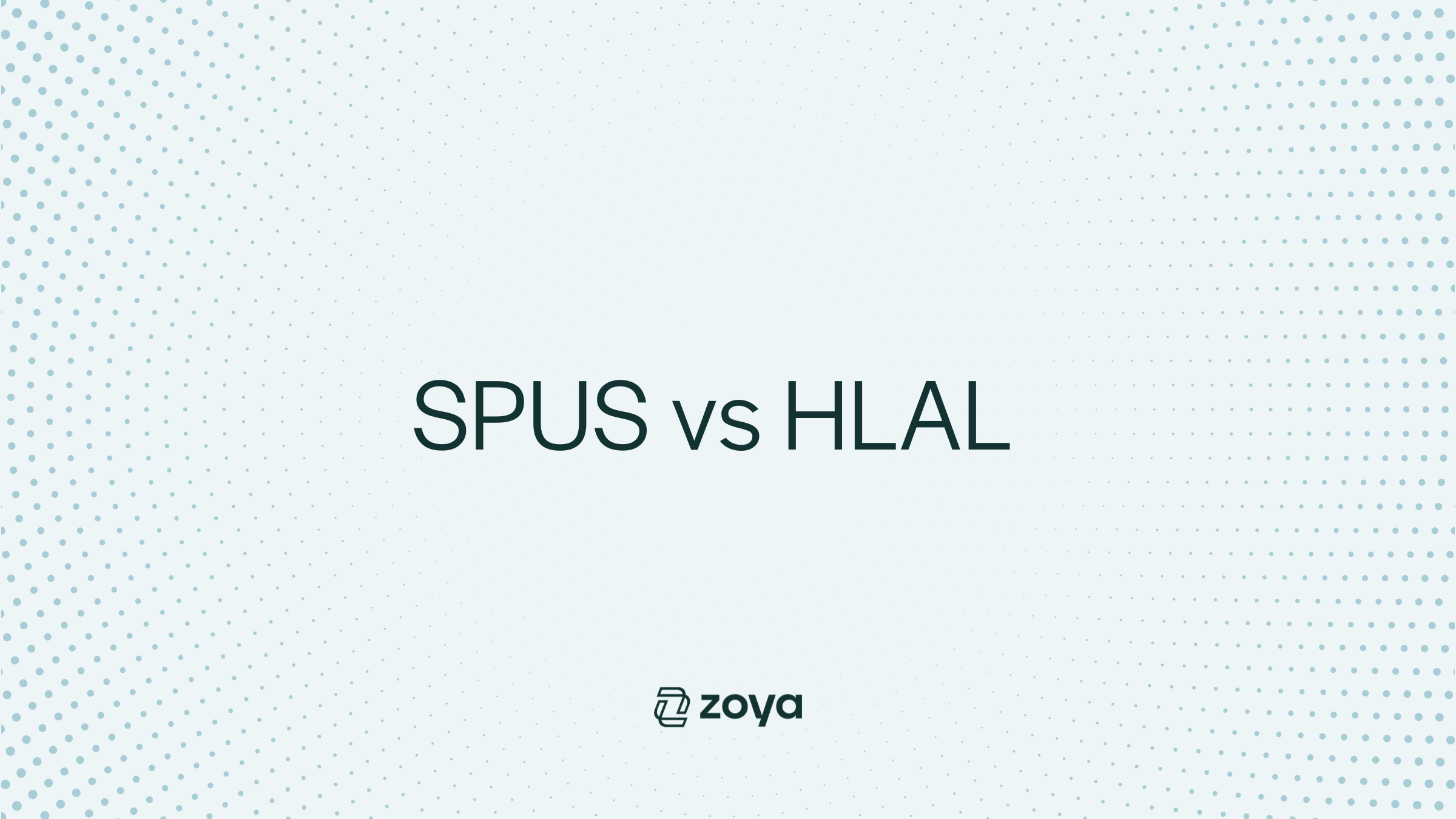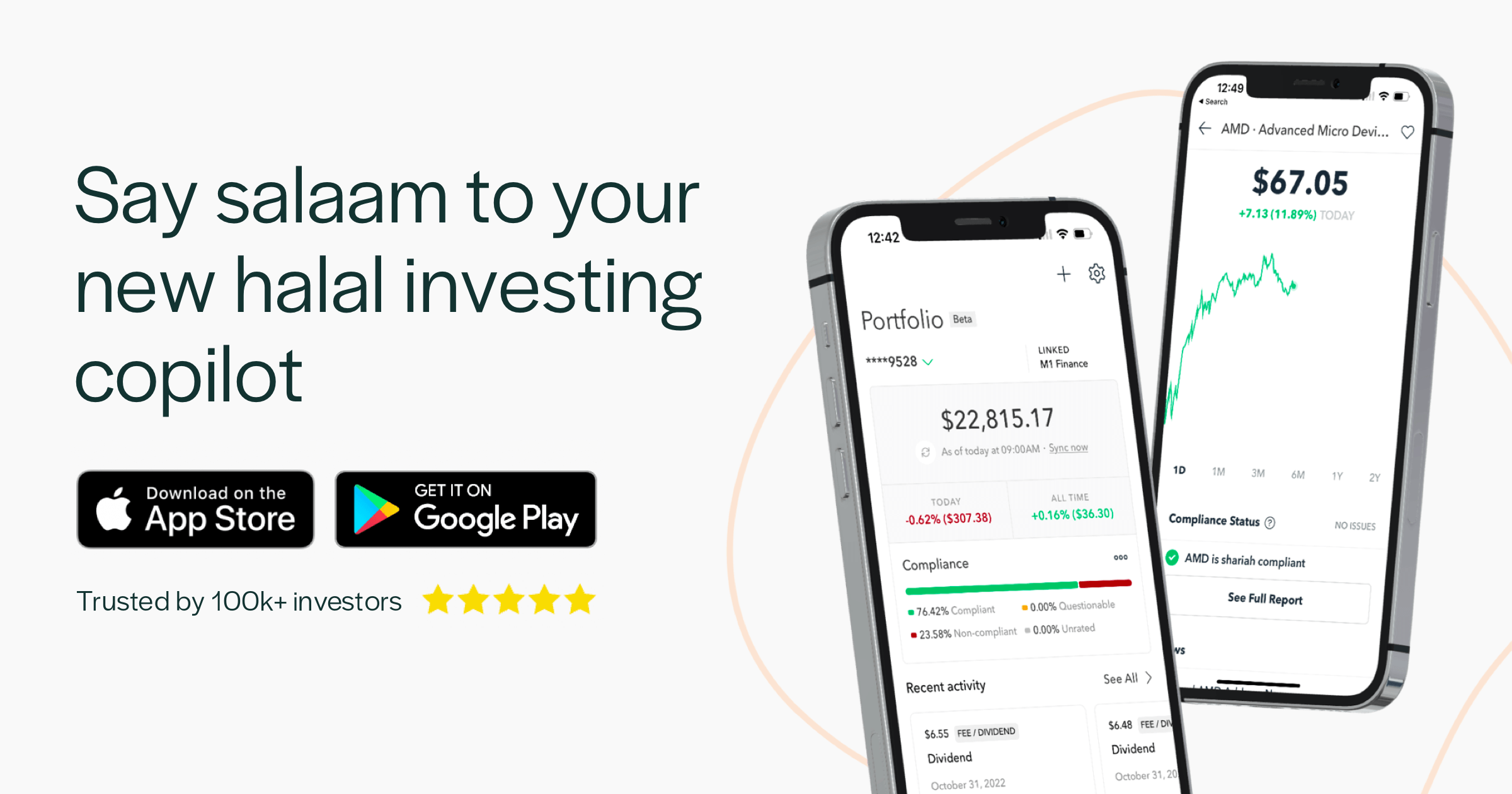SPUS vs. HLAL: Which Halal ETF Should You Invest In?

Halal investing is growing, and the SP Funds S&P 500 Sharia Industry Exclusions ETF (SPUS) and Wahed FTSE USA Shariah ETF (HLAL) are two of the most popular options when it comes to Shariah-compliant index funds. But which one suits your portfolio best?
While both ETFs aim to provide halal investment opportunities, they differ in index composition, sector allocation, cost, and overall performance. This guide will break down these differences so you can decide which halal ETF best fits your portfolio.
Table of contents
- Key differences between SPUS and HLAL at a glance
- Index composition
- Sector and portfolio diversification
- Historical performance analysis
- Cost comparison and liquidity
- Dividend yield and income potential
- Zakat calculation for SPUS and HLAL
- Which is better: SPUS or HLAL?
- Bottom line
- Frequently asked questions

Zoya: Halal Investing App
Zoya makes halal investing easy by helping you build and monitor a shariah compliant investment portfolio with confidence and clarity.
Key differences between SPUS and HLAL at a glance
The table below is a quick comparison of SPUS and HLAL, outlining their key characteristics.
| Metric | SPUS | HLAL |
|---|---|---|
| Index Tracked | S&P 500 Sharia Industry Exclusions Index | FTSE USA Shariah Index |
| Expense Ratio | 0.45% | 0.50% |
| Holdings | ~200 large-cap S&P 500 stocks | 219 large/mid-cap U.S. stocks |
| Top Sector | Technology | Technology |
| Dividend Yield | 0.70% | 0.56% |
| 5-Year Return | 17.64% annualized | 15.79% annualized |
Index composition
At their core, both SPUS and HLAL aim to provide Shariah-compliant exposure to the U.S. equity market, but they take different approaches.
SPUS tracks the S&P 500 Sharia Industry Exclusions Index, which means it filters out non-compliant industries from the S&P 500 while maintaining exposure to large-cap stocks. HLAL, on the other hand, follows the FTSE USA Shariah Index, incorporating both large and mid-cap stocks in its portfolio.
Sector and portfolio diversification
Both SPUS and HLAL demonstrate similarities in their investment approach, particularly in their sector allocations and top holdings. This similarity stems from their shared focus on large-cap U.S. equities.
Sector concentration
Sector exposure plays a key role in performance. Both SPUS and HLAL have significant allocations to technology stocks, with SPUS at 45.76% and HLAL at 42.81%. While SPUS has a marginally higher tech exposure, the difference is small and unlikely to cause major divergence in returns.
| Sector | SPUS Weighting | HLAL Weighting |
|---|---|---|
| Technology | 45.76% | 42.81% |
| Consumer Discretionary | 13.74% | 6.49% |
| Healthcare | 11.21% | 11.85% |
| Communication Services | 8.04% | 12.03% |
| Industrials | 7.07% | 7.31% |
| Consumer Staples | 3.5% | 4.33% |
| Energy | 2.97% | 6.01% |
| Materials | 2.52% | 3.31% |
| Real Estate | 0.94% | 1.03% |
| Utilities | 0.3% | 0.52% |
| Other | 3.95% | 4.31% |
Aside from technology, both ETFs allocate assets across consumer cyclical, healthcare, and communication services sectors. HLAL provides slightly more diversification across industries, but both funds remain primarily driven by large-cap growth stocks.
Top holdings
When examining their top holdings, both ETFs show significant overlap in their largest positions, particularly in major tech companies. SPUS's top three holdings are Apple (11.24%), NVIDIA (10.35%), and Microsoft (9.23%), collectively accounting for about 31% of the fund. HLAL shows similar concentration in tech giants, with Apple being its largest holding at 15.13%.
| Rank | SPUS Holdings | HLAL Holdings |
|---|---|---|
| 1 | Apple Inc. | Apple Inc. |
| 2 | Microsoft Corp. | Microsoft Corp. |
| 3 | Alphabet Inc. | Tesla Inc. |
| 4 | Tesla Inc. | Nvidia Corp. |
| 5 | Nvidia Corp. | Alphabet Inc. |
| 6 | Meta Platforms | Meta Platforms |
| 7 | Broadcom Inc. | Broadcom Inc. |
| 8 | Texas Instruments | Texas Instruments |
| 9 | Adobe Inc. | Adobe Inc. |
| 10 | Salesforce Inc. | Salesforce Inc. |
Key differences emerge in position sizes and overall portfolio construction. SPUS appears to have more concentrated positions in its top holdings, with its top 10 making up around 56.5% of the portfolio. HLAL, while still maintaining significant positions in major tech companies, shows relatively more diversified weightings across its holdings.
Both ETFs maintain exposure across other sectors through holdings in healthcare (Eli Lilly in SPUS; Abbott Laboratories in HLAL) and various industrial and consumer companies. However, HLAL provides slightly more diversification across industries, with smaller but more numerous positions in companies like Agilent Technologies, Analog Devices, and Archer-Daniels-Midland.
This diversification approach means that while both funds remain primarily driven by large-cap growth stocks, HLAL might offer marginally better protection against company-specific risks through its more distributed allocation strategy.
Historical performance analysis
Since their launches in 2019, both ETFs have delivered strong returns, but with slightly different risk profiles:
| Metric | SPUS | HLAL |
|---|---|---|
| 2024 Return | 26.49% | 16.69% |
| 2023 Return | 34.24% | 30.12% |
| 5-Year Annualized Return | 17.64% | 15.79% |
| Standard Deviation | 18.87% | 18.94% |
| Sharpe Ratio | 0.82 | 0.73 |
Annualized returns
Annualized return is the average rate of return per year over a given period, taking into account the effect of compounding. This helps smooth out short-term fluctuations and provides a clearer picture of long-term performance.
Over the past five years, SPUS has outperformed HLAL, delivering an annualized return of 17.64% compared to HLAL's 15.79%. This outperformance can largely be attributed to its greater technology exposure during a period of exceptional tech sector growth.
Volatility
Volatility is another consideration. In simple terms, volatility measures how much the price of an asset fluctuates over time. A higher number means the price swings more dramatically, while a lower number suggests more stability.
SPUS has a standard deviation of 18.87%, while HLAL’s is 18.94%, based on a 5-year period. This means both ETFs experience similar levels of price movement over the long term. While these percentages may seem high, they are typical for equity-based funds, especially those with a strong focus on growth stocks.
Sharpe ratio
The Sharpe ratio measures an investment’s return relative to its risk. A higher Sharpe ratio indicates better risk-adjusted performance, meaning the ETF provides more return per unit of risk.
SPUS has a Sharpe ratio of 0.82, meaning it has historically offered better risk-adjusted returns compared to HLAL's 0.73.
Cost comparison and liquidity
Both SPUS and HLAL charge slightly higher expense ratios than conventional ETFs, but they remain competitive within the Shariah-compliant space. SPUS has an expense ratio of 0.45%, while HLAL’s is 0.50%. These costs are important to consider for long-term investors, as expense ratios can impact overall returns over extended holding periods.
SPUS has a lower bid-ask spread (~4.12%), making it easier to trade. In contrast, HLAL’s higher bid-ask spread (~6.08%) means you might pay slightly more when buying or selling shares.
Additionally, SPUS has higher trading volume and net assets of $1.08 billion, compared to HLAL’s $600 million, suggesting better liquidity. Liquidity is often an important factor for traders, but for long-term investors, it’s generally less of a concern. Since both SPUS and HLAL are designed as passive index-tracking funds meant for long-term holding, their liquidity differences are not a major deciding factor.
Dividend yield and income potential
For those seeking dividend income, SPUS offers a slightly higher yield at 0.70%, compared to HLAL’s 0.56%. However, both ETFs provide lower yields than conventional broad-market ETFs because they exclude financial sector stocks, which typically pay higher dividends.
If maximizing dividend income is a priority, consider supplementing your portfolio with dividend-focused stocks or other income-generating assets, such as sukuk (Islamic bonds).
Zakat calculation for SPUS and HLAL
When investing in ETFs, a portion of your holdings is subject to zakat because the companies within these funds hold cash, receivables, and other liquid assets. Since each company maintains different levels of these assets, the zakat liability varies from fund to fund.
According to Zoya’s zakat calculator, which analyzes each underlying company in the fund individually to provide a more precise calculation, approximately 11.7% of SPUS and 14.2% of HLAL is considered zakatable—the portion of your investment on which zakat must be paid.
For a $10,000 investment, this would translate to around $1,170 for SPUS and $1,420 for HLAL. Since zakat is calculated at 2.5%, the final amount due would be $29.25 for SPUS and $35.50 for HLAL.
While the difference is small, HLAL has a slightly higher zakatable percentage due to its portfolio composition.
Which is better: SPUS or HLAL?
Your choice between SPUS and HLAL depends on your investing goals and risk tolerance. Here’s a quick guide to help you decide:
Consider SPUS if:
- You want slightly higher historical returns.
- You are comfortable with a tech-heavy allocation.
- You prefer an ETF with higher liquidity and lower bid-ask spreads.
Consider HLAL if:
- You prefer a more balanced allocation across multiple sectors.
- You want exposure beyond just large-cap stocks.
- You are a long-term investor who is less concerned about liquidity.
For a well-rounded approach, you might consider holding both ETFs in your portfolio to gain exposure to their respective strengths.
Bottom line
Both SPUS and HLAL are strong choices for Shariah-compliant investors. SPUS has slightly outperformed HLAL historically, but the differences in sector allocation and diversification are relatively minor. If you prefer higher historical returns and liquidity, SPUS may be the better choice. If you value a slightly broader market exposure, HLAL could be a better fit.
Ultimately, your decision should align with your investment objectives and risk tolerance. Whichever ETF you choose, both provide a solid foundation for halal investing in the U.S. equity market.
Frequently asked questions
What is SPUS?
SPUS (SP Funds S&P 500 Sharia Industry Exclusions ETF) is an exchange-traded fund that tracks large-cap U.S. companies from the S&P 500, excluding those that do not meet the criteria for Shariah compliance.
What does SPUS consist of?
SPUS consists of approximately 200 large-cap stocks from the S&P 500, with a significant allocation to the technology sector.
Is SPUS really halal?
Yes, SPUS is certified Shariah-compliant and approved by a board of scholars. It excludes companies involved in prohibited activities like alcohol, tobacco, gambling, and conventional financial services. It tracks the S&P 500 Shariah Industry Exclusions Index.
When does SPUS pay dividends?
SPUS pays dividends monthly.
What is HLAL?
HLAL (Wahed FTSE USA Shariah ETF) is an exchange-traded fund that provides exposure to both large and mid-cap U.S. companies that pass the criteria for Shariah compliance.
What does HLAL track?
HLAL tracks the FTSE USA Shariah Index, which includes both large and mid-cap U.S. companies that pass Shariah compliance screening.
How many companies are in HLAL?
HLAL currently holds around 219 companies in its portfolio.
Where can I buy SPUS and HLAL?
You can invest in SPUS and HLAL through major U.S. brokers including Robinhood, Vanguard, Fidelity, and Interactive Brokers (IBKR).
How can I invest in SPUS from the UK?
SPUS is only available in the US, but HLAL is dual-listed and can be traded in both the US and UK. Another UK-listed alternative is the iShares MSCI USA Islamic UCITS ETF (ISUS). Alternatively, you can use a broker like Interactive Brokers to access SPUS from abroad.